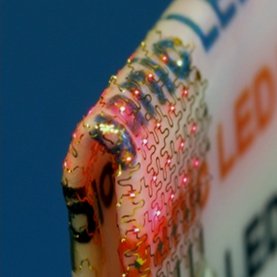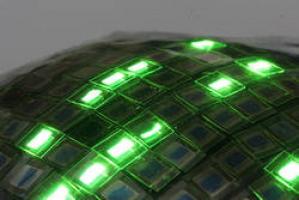Researchers create a flexible array of inorganic LEDs
Researchers led by John Rogers from the University of Illinois have developed a stretchable/bendable sheets of LEDs and light sensors. They are interested in applications that interface with the human body, and so they prefer inorganic LEDs to OLEDs as they are brighter, more reliable and are more easily made waterproof.

The team has printed an interlaced array of LEDs, on a rigid wafer, then dissolved the top layer of the substrate to release a thin network of LEDs that can be transferred to a flexible, waterproof polymer sheet. Each LED is just 100 microns across (about the width of a human hair) and 2.5 microns thick and is connected to its neighbors by serpentine strands that can accommodate the deformation of stretching and twisting. They managed to put the arrays on aluminum foils, leaves ,sheets of paper and around nylon threads.




